

Compact Muon Solenoid
LHC, CERN
| CMS-PAS-BPH-15-003 | ||
| Measurements of correlations between J/ψ mesons and jets produced in √s= 8 TeV pp collisions | ||
| CMS Collaboration | ||
| May 2019 | ||
| Abstract: A study of the production of J/ψ mesons in conjunction with jets in pp collisions at √s= 8 TeV is presented. The analysis is based on data corresponding to an integrated luminosity of 19.1 fb−1 collected with the CMS detector at the LHC. For events with at least one observed jet, the angular separation between the J/ψ meson and the jet is used to test whether the J/ψ meson is a jet fragment. The differential distributions of jet fragmentation probability as a function of jet energy for a fixed J/ψ energy fraction z are presented. The experimental results are compared to a theoretical model using the fragmenting jet function (FJF) approach. The J/ψ jet fragmentation data agree with the predictions of the FJF calculations that use specific long-distance matrix element parameters. This agreement shows that the combination of data on jet fragmentation to J/ψ mesons and FJF analysis is a new way to test predictions for charmonium production from nonrelativistic quantum chromodynamics and to evaluate long-distance matrix element parameter sets. The analysis also shows that most J/ψ mesons with energy above 15 GeV and rapidity |y|< 1.0 are fragments of jets with pseudorapidity |ηjet|< 1. | ||
|
Links:
CDS record (PDF) ;
CADI line (restricted) ;
These preliminary results are superseded in this paper, PLB 804 (2020) 135409. The superseded preliminary plots can be found here. |
||
| Figures | |
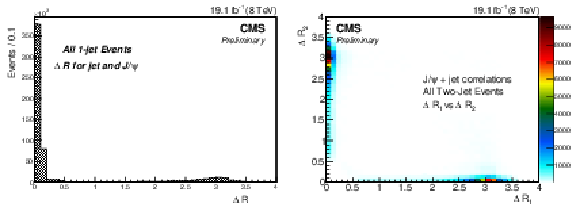
png pdf |
Figure 1:
Left: The ΔR for J/ψ events with one observed jet. Right: The ΔR1 vs. ΔR2 for two-jet events, where ΔR1 is associated with the higher-energy jet and ΔR2 with the lower-energy jet. |
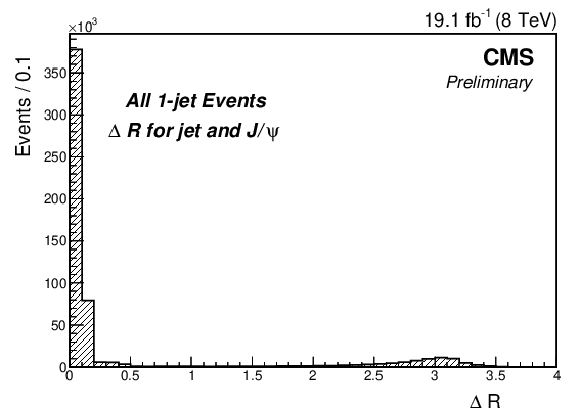
png pdf |
Figure 1-a:
The ΔR for J/ψ events with one observed jet. |
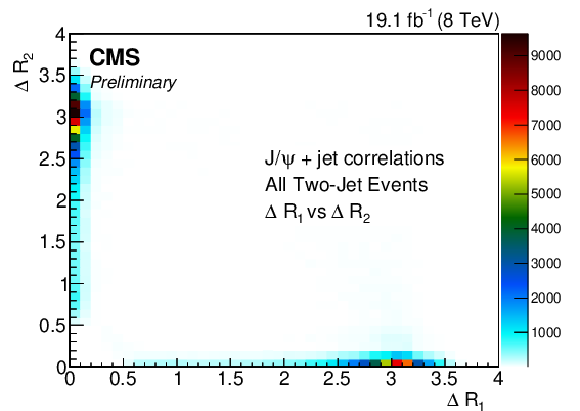
png pdf |
Figure 1-b:
The ΔR1 vs. ΔR2 for two-jet events, where ΔR1 is associated with the higher-energy jet and ΔR2 with the lower-energy jet. |

png pdf |
Figure 2:
Comparison of data (closed circles with vertical bars representing the statistical uncertainty (inner bars) and total uncertainty (outer bars)) with the four LDME terms for z1 = 0.425, using: (left) the BCKL LDME set [18]; and (right) the BK LDME set [17]. The curves show the jet energy dependence of the FJF model predictions, from which the averages were calculated. |
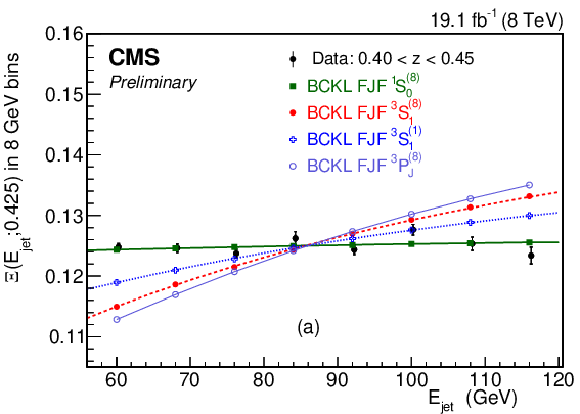
png pdf |
Figure 2-a:
Comparison of data (closed circles with vertical bars representing the statistical uncertainty (inner bars) and total uncertainty (outer bars)) with the four LDME terms for z1 = 0.425, using the BCKL LDME set [18]. The curves show the jet energy dependence of the FJF model predictions, from which the averages were calculated. |
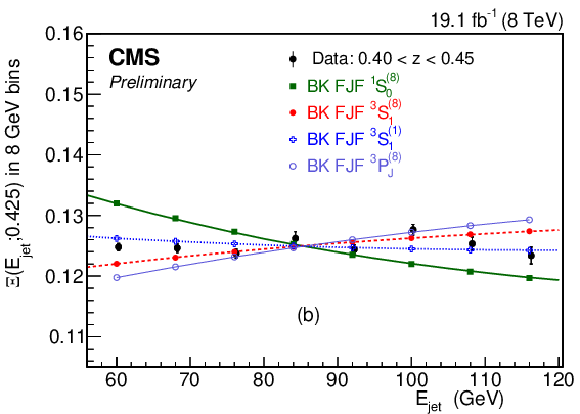
png pdf |
Figure 2-b:
Comparison of data (closed circles with vertical bars representing the statistical uncertainty (inner bars) and total uncertainty (outer bars)) with the four LDME terms for z1 = 0.425, using the BK LDME set [17]. The curves show the jet energy dependence of the FJF model predictions, from which the averages were calculated. |

png pdf |
Figure 3:
Comparison of data (closed circles with vertical bars representing the statistical uncertainty (inner bars) and total uncertainty (outer bars)) with the four LDME terms for z1= 0.525, using: (left) the BCKL LDME set [18]; and (right) the BK LDME set [17]. The curves show the jet energy dependence of the FJF model predictions, from which the averages were calculated. |

png pdf |
Figure 3-a:
Comparison of data (closed circles with vertical bars representing the statistical uncertainty (inner bars) and total uncertainty (outer bars)) with the four LDME terms for z1= 0.525, using the BCKL LDME set [18]. The curves show the jet energy dependence of the FJF model predictions, from which the averages were calculated. |
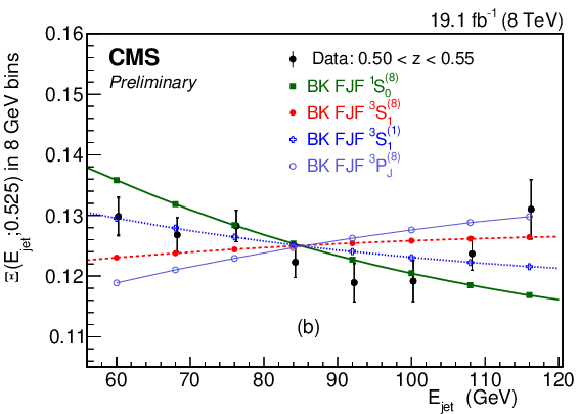
png pdf |
Figure 3-b:
Comparison of data (closed circles with vertical bars representing the statistical uncertainty (inner bars) and total uncertainty (outer bars)) with the four LDME terms for z1= 0.525, using the BK LDME set [17]. The curves show the jet energy dependence of the FJF model predictions, from which the averages were calculated. |
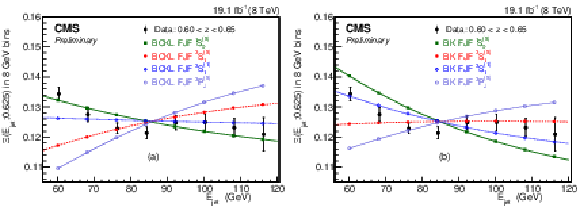
png pdf |
Figure 4:
Comparison of data (closed circles with vertical bars representing the statistical uncertainty (inner bars) and total uncertainty (outer bars)) with the four LDME terms for z1= 0.625, using: (left) the BCKL LDME set [18]; and (right) the BK LDME set [17]. The curves show the jet energy dependence of the FJF model predictions, from which the averages were calculated. |
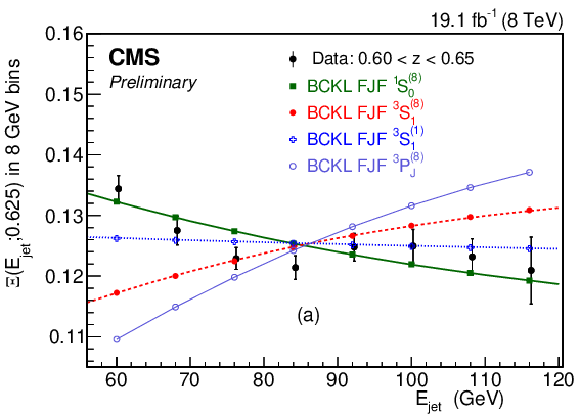
png pdf |
Figure 4-a:
Comparison of data (closed circles with vertical bars representing the statistical uncertainty (inner bars) and total uncertainty (outer bars)) with the four LDME terms for z1= 0.625, using the BCKL LDME set [18]. The curves show the jet energy dependence of the FJF model predictions, from which the averages were calculated. |
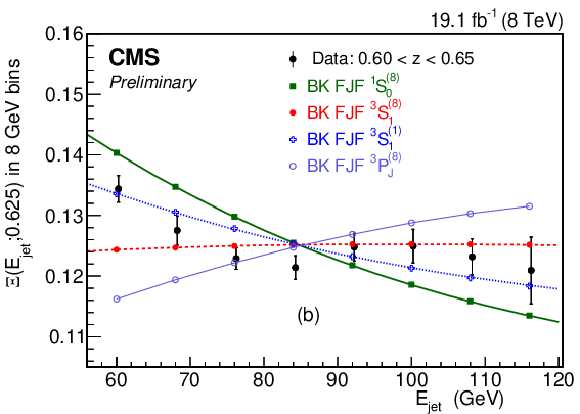
png pdf |
Figure 4-b:
Comparison of data (closed circles with vertical bars representing the statistical uncertainty (inner bars) and total uncertainty (outer bars)) with the four LDME terms for z1= 0.625, using the BK LDME set [17]. The curves show the jet energy dependence of the FJF model predictions, from which the averages were calculated. |
| Tables | |

png pdf |
Table 1:
The values of the χ2 and the χ2 probability (in parentheses) for 7 degrees of freedom in the comparison of the data and the FJF prediction for each LDME term with z1 = 0.425. |

png pdf |
Table 2:
The values of the χ2 and the χ2 probability (in parentheses) for 7 degrees of freedom in the comparison of the data and the FJF prediction for each LDME term with z1 = 0.525. |

png pdf |
Table 3:
The values of the χ2 and the χ2 probability (in parentheses) for 7 degrees of freedom in the comparison of the data and the FJF prediction for each LDME term with z1= 0.625. |
| Summary |
|
The first analysis comparing data for J/ψ mesons produced as fragmentation products of a central gluonic jet with a theoretical analysis based on Fragmenting Jet Function (FJF) approach has been presented. The data were collected by the CMS Collaboration from pp collisions at √s= 8 TeV, corresponding to an integrated luminosity of 19.1 fb−1. The agreement between the data and the FJF predictions over a wide range of z, where z is the J/ψ fraction of the jet energy, validates the FJF approach for gluon fragmentation. For the three z values, 0.425, 0.525, and 0.625, the nonrelativistic quantum chromodynamic long-distance matrix element (LDME) terms for the 3S(8)1 and 3P(8)J configurations are not dominant for either the Bodwin, Chung, Kim and Lee (BCKL) [18] or Butenschoen and Kniehl (BK) [17] parameter sets, ie, these terms are not the main contributors to J/ψ production by jet fragmentation. For the BCKL LDME parameters, the 1S(8)0 term dominates jet fragmentation to J/ψ for all three z values studied. This could explain the small J/ψ polarization at large pT observed in high energy hadronic collisions at the Tevatron and LHC. However, the possible role of the 3S(1)1 term using the BK parameters, with its implied large J/ψ polarization, has to be addressed theoretically. It has almost the same jet energy dependence as the BCKL 1S(8)0 term for z> 0.5, but not for lower z. For events with one observed jet, 84% of J/ψ mesons with E> 15 GeV and |y|< 1 are fragments of a jet produced in the angular region |η|< 1.0. We have also demonstrated that some J/ψ mesons are fragments of jets that fail the requirement pT|jet> 25 GeV. Using a simple model to estimate the fraction of J/ψ mesons that are fragments of unobserved jets, we find that jet fragmentation can be the source of > 80% of the J/ψ mesons produced in this kinematic region. |
| References | ||||
| 1 | E598 Collaboration | Experimental observation of a heavy particle J | PRL 33 (1974) 1404 | |
| 2 | J.-E. Augustin et al. | Discovery of a narrow resonance in e+e− annihilation | PRL 33 (1974) 1406 | |
| 3 | C.-H. Chang | Hadronic production of J/ψ associated with a gluon | NPB 172 (1980) 425 | |
| 4 | R. Baier and R. Ruckl | Hadronic production of J/ψ and Υ: transverse momentum distributions | PLB 102 (1981) 364 | |
| 5 | CDF Collaboration | J/ψ, ψ′→μ+μ− and B→J/ψ, ψ′ cross-sections | in 27th International Conference on High-energy Physics (ICHEP 94) Glasgow, Scotland, July 20-27, 1994 1994 | hep-ex/9412013 |
| 6 | CDF Collaboration | J/ψ and ψ(2S) production in pˉp collisions at √s= 1.8 TeV | PRL 79 (1997) 572 | |
| 7 | P. Cho and A. K. Leibovich | Color-octet quarkonia production | PRD 53 (1996) 150 | |
| 8 | P. Cho and A. K. Leibovich | Color-octet quarkonia production. II | PRD 53 (1996) 6203 | |
| 9 | P. Artoisenet et al. | Υ Production at Fermilab Tevatron and LHC energies | PRL 101 (2008) 152001 | |
| 10 | P. Faccioli et al. | Quarkonium production in the LHC era: a polarized perspective | PLB 736 (2014) 98 | 1403.3970 |
| 11 | M. Procura and I. W. Stewart | Quark fragmentation within an identified jet | PRD 81 (2010) 074009 | 0911.4980 |
| 12 | A. Jain, M. Procura, and W. J. Waalewijn | Parton fragmentation within an identified jet at NNLL | JHEP 05 (2011) 035 | 1101.4953 |
| 13 | M. Procura and W. J. Waalewijn | Fragmentation in jets: cone and threshold effects | PRD 85 (2012) 114041 | 1111.6605 |
| 14 | M. Baumgart, A. K. Leibovich, T. Mehen, and I. Z. Rothstein | Probing quarkonium production mechanisms with jet substructure | JHEP 1411 (2014) 003 | 1406.2295 |
| 15 | G. Altarelli and G. Parisi | Asymptotic freedom in parton language | NPB126 (1977) 298--318 | |
| 16 | L. Dai and P. Shrivastava | Quarkonium polarization and the long distance matrix elements hierarchies using jet substructure | 1707.08629 | |
| 17 | M. Butenschoen and B. A. Kniehl | Next-to-leading-order tests of NRQCD factorization with J/ψ yield and polarization | MPLA 28 (2013) 1350027 | 1212.2037 |
| 18 | G. T. Bodwin, H. S. Chung, U.-R. Kim, and J. Lee | Fragmentation contributions to J/ψ production at the Tevatron and the LHC | PRL 113 (2014) 022001 | 1403.3612 |
| 19 | K.-T. Chao et al. | J/ψ polarization at hadron colliders in nonrelativistic QCD | PRL 108 (Jun, 2012) 242004 | 1201.2675 |
| 20 | LHCb Collaboration | Study of J/ψ production in jets | PRL 118 (2017) 192001 | 1701.05116 |
| 21 | CMS Collaboration | The CMS experiment at the CERN LHC | JINST 3 (2008) S08004 | CMS-00-001 |
| 22 | CMS Collaboration | J/ψ and ψ(2S) production in pp collisions at √s= 7 TeV | JHEP 02 (2012) 011 | CMS-BPH-10-014 1111.1557 |
| 23 | CMS Collaboration | Measurement of J/ψ and ψ(2S) prompt double-differential cross sections in pp collisions at √s= 7 TeV | PRL 114 (2015) 191802 | CMS-BPH-14-001 1502.04155 |
| 24 | CMS Collaboration | Measurements of the Υ(1S), Υ(2S), and Υ(3S) differential cross sections in pp collisions at √s= 7 TeV | PLB 749 (2015) 14 | CMS-BPH-12-006 1501.07750 |
| 25 | CMS Collaboration | Performance of CMS muon reconstruction in pp collision events at √s= 7 TeV | JINST 7 (2012) P10002 | CMS-MUO-10-004 1206.4071 |
| 26 | CMS Collaboration | Particle-flow reconstruction and global event description with the cms detector | JINST 12 (2017) P10003 | CMS-PRF-14-001 1706.04965 |
| 27 | CMS Collaboration | Determination of jet energy calibration and transverse momentum resolution in CMS | JINST 6 (2011) P11002 | CMS-JME-10-011 1107.4277 |
| 28 | D. Lange | The EvtGen particle decay simulation package | NIMA 462 (2001) 152 | |
| 29 | E. Barberio, B. van Eijk, and Z. W\cas | PHOTOS: A universal Monte Carlo for QED radiative corrections in decays | CPC 66 (1991) 115 | |
| 30 | S. Agostinelli et al. | GEANT4 -- a simulation toolkit | Nucl. Instr. Meth. A 506 (2003) 250 | |
| 31 | CMS Collaboration | Muon ID Performance: low-pT muon efficiencies | CMS DP-2014/020 | |
| 32 | T. Adye | Unfolding algorithms and tests using RooUnfold | in Proceedings, PHYSTAT 2011 Workshop on Statistical Issues Related to Discovery Claims in Search Experiments and Unfolding, CERN,Geneva, Switzerland 17-20 January 2011, pp. 313--318, CERN CERN, Geneva | 1105.1160 |
| 33 | CDF Collaboration | Polarizations of J/ψ and ψ(2S) mesons produced in p¯p Collisions at √s=1.96TeV | PRL 99 (2007) 132001 | |
| 34 | CMS Collaboration | Measurement of the prompt J/ψ and ψ(2S) polarizations in pp collisions at √s= 7 TeV | PLB 727 (2013) 381 | CMS-BPH-13-003 1307.6070 |

|
Compact Muon Solenoid LHC, CERN |

|

|

|

|

|

|